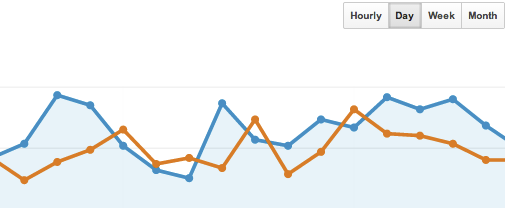One of the biggest mistakes Internet marketers make is not tracking their organic SEO campaign results. Use the following metrics to improve your Internet marketing campaigns, provide a better experience for your visitors, and drive more targeted traffic to your website.
1. Sessions / Users
Where to find it:
This information will be on the home of your Google Analytics dashboard, but you can always access it along the left hand side by clicking “Overview” under “Audience”
How to use it:
Tracking Sessions and Users will give you an idea of how your site is performing overall. Sessions represent every individual visit to your website, and Users are each unique visitor to the site.
Compare Date Ranges to measure a campaign or a marketing effort’s impact on a site you need to track changes in web traffic over time. To do this:
-In the upper right hand you’ll see a date range.
-Click on the right down arrow to adjust this range. If you’d like to compare two time periods against each other check the “compare to” box.
2. Conversions
Where to find it:
Conversions need to be set up in the admin section of Google Analytics. Click the admin link in the top navigation find the property you’d like to set a conversion for.
Find the “Goals” link under view on the far right then follow the steps to create a new goal.
How to use it:
Creating goal conversions should be the first thing any Internet marketer does when setting up Google Analytics for a client. It’s important to not only track sales, but the actions that lead to sales as well.
Consider setting the following conversions:
- Contact Us
- Clicks to social media sites
- Form Completions
- PDF Downloads
- Quote Requests
3. Bounce Rate/ Session Duration
Where to find it:
A general site-wide bounce rate and session duration statistics can be found under Audience Overview, but we prefer to dig deeper and learn information about our pages individually to get a better understanding of what’s working for a site.
To do this we click Behavior (on the left hand site)> Site Content (dropdown)> All Pages
Here you’ll find significant statistics about every page of your website.
How to use it:
Google has been increasing the signal strength of user experience over the past few months. Websites with high bounce rate and short session durations will fall in search rankings. Use this information to make changes to the pages that aren’t performing well. Remember to focus on the value you are providing to your visitors.
4. Organic Search Traffic
Where to find it:
You’ll find information about you Organic Search traffic by clicking the Channels link under Acquisition along the left-hand side.
Once you get there, click Organic Search.
This will bring you to a list of keywords visitors used to find your website. Unfortunately, Google has been increasingly reluctant to share keywords with its users in recent years. If you’re looking for specific search terms you’ll need to use a third party tool, but a quick look at landing pages will give you a good idea of which keyword groups are driving traffic. View source and landing pages by clicking the links in the Primary Dimension navigation.
How to use it:
In order to increase organic traffic to a site, a marketer needs to have an understanding of what words are driving the existing traffic to your website. Use this tool to understand how users are finding your site and see what landing pages need to be beefed up.
5. Referral Traffic
Where to find it:
This metric is another Acquisition Channel, so you’ll start by visiting that page again.
This time click on the Referral link. This will bring you to a list of third party sources driving traffic to your website. Again you can also view the landing pages that the referral traffic is being sent to.
How to use it:
Monitoring referral traffic is the best way to track your backlink strategy. Quality backlinks are one of the top metrics Google uses to rank websites in their search results. Checking referral traffic is a must for marketers who are interesting in learning how visitors are finding a website.
These are just a few of the ways you can track the KPI’s and success of your organic SEO marketing campaign whether you are doing the work yourself or have hired a Nashville digital marketing agency.
- Author Details


